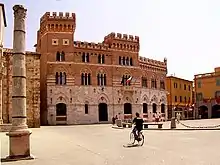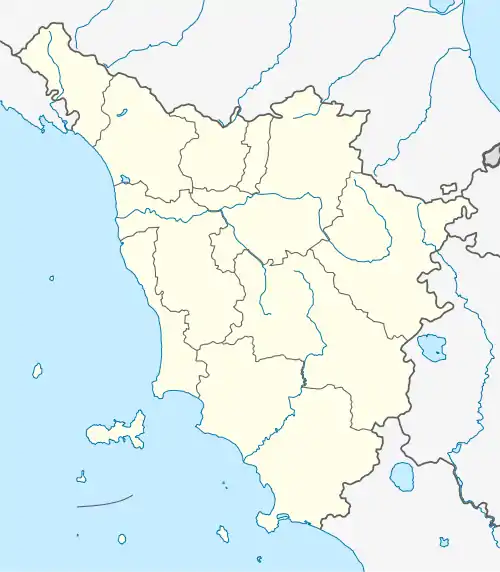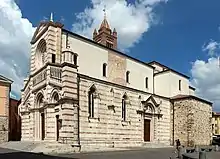Piazza Dante, Grosseto
Piazza Dante (also known as Piazza delle Catene, lit. 'Chains' Square') is the main public square in Grosseto, Tuscany, Italy.
| Piazza delle Catene | |
 | |
 Shown within Tuscany | |
| Former name(s) | Piazza del Comune Piazza Grande Piazza Vittorio Emanuele II Piazza Ettore Muti |
|---|---|
| Namesake | Dante Alighieri |
| Location | Grosseto, Tuscany, Italy |
| Coordinates | 42°45′34″N 11°06′49″E |
| Construction | |
| Completion | 13th century |
| Other | |
| Status | pedestrianised |
The piazza is located in the city's historic centre, included within the perimeter of the 16th-century city walls.[1] It is home to the city's main representative buildings, including the St. Lawrence Cathedral, the Palazzo Comunale (City Hall) and the Palazzo Aldobrandeschi, seat of the Province of Grosseto.[2] The northern section of the square is called Piazza Duomo, since it is overlooked by the cathedral's façade.[3]
History
The main square of the city of Grosseto is documented as Platea Communis starting from 1222.[4][5]
Buildings and monuments

.jpg.webp)
.jpg.webp)
Grosseto Cathedral
Palazzo Aldobrandeschi
Palazzo Comunale
The Palazzo Comunale is located on the northern side of Piazza Duomo and houses the City Council and the Mayor of Grosseto. The city hall was designed in 1867 by engineer Giovanni Clive, and built in a Neo-Renaissance style between 1870 and 1873. Its construction required the demolition of the 16th-century church of San Giovanni Decollato (St. John the Baptist) which stood here.[6]
Palazzo Alben
Palazzo Alben is located on the western side of Piazza Duomo, opposite the cathedral. The palace was built between 1948 and 1950 by the enterprise ALBEN, on the site of the medieval Palazzo dei Priori, which was demolished in 1938 by the Fascist city government in order to build the new headquarters of the National Institute for Social Security.[7] It is home to the Banca Nazionale del Lavoro.[8]
Canapone
The statue of Leopold II of Tuscany (Italian: monumento a Leopoldo II di Lorena), better known as Canapone, is a white marble monument located at the centre of the square. It was sculpted by artist Luigi Magi, and positioned in 1846.[9] It represents Leopold II, Grand Duke of Tuscany dressed as an ancient Roman, in the act of holding up with his left hand a woman, who bears a dead child, and with his right arm a smiling boy; the grand duke's right foot crushes the head of a snake, which is also devoured by a griffin.[9][10] The allegorical sculpture was meant to celebrate the land reforms and reclamations perpetrated by the grand duke, who is depicted here as a Roman sage and saviour who comes to succour the Maremma (the woman) who has suffered for generations (the dead child); the next generation (the smiling boy) will be grateful to the grand duke who defeated the malaria (the snake), also thanks to the strength and sacrifice of the people of Grosseto (the griffin).[9][10]
Colonna dei Bandi
The Colonna dei Bandi (lit. 'Column of notices') is an ancient Roman column located in the northern side of the square, on the right of the cathedral. Its presence in the piazza is attested to 1617, and confirmed in later records until 1832, and was used as the public spot to post municipal notices (bandi).[11] The original column was removed in 1846 with the square's renovation and went lost. The current monument – a 2nd century AD column found in Rusellae in 1863 – was placed on the same site in 1966, during the celebration of the bicentenary of the establishment of the Province of Grosseto.[11]
References
- "Piazza Dante". Atlante storico topografico di Grosseto (in Italian). Archived from the original on 2014-07-28.
- Guide d'Italia. Toscana. Milan: Touring Club Italiano. 2012. pp. 882–884.
- "Piazza Duomo". Atlante storico topografico di Grosseto (in Italian). Archived from the original on 2014-07-28.
- "La realizzazione della Platea Communis". Atlante storico topografico di Grosseto (in Italian). Archived from the original on 2014-07-28.
- Celuzza, Mariagrazia; Papa, Mauro (2013). Grosseto visibile. Guida alla città e alla sua arte pubblica. Arcidosso: Edizioni Effigi. pp. 119–121.
- Celuzza; Papa. Grosseto visibile. pp. 110–111.
- Innocenti, Mario; Innocenti, Elena (2005). Grosseto: briciole di storia. Cartoline e documenti d'epoca 1899-1944. Grosseto: Editrice Innocenti. p. 173.
- Celuzza; Papa (2013). Grosseto visibile. p. 124.
- Celuzza; Papa (2013). Grosseto visibile. pp. 121–122.
- "Il monumento a Canapone". Atlante storico topografico di Grosseto (in Italian). Archived from the original on 2014-07-28.
- Celuzza; Papa (2013). Grosseto visibile. pp. 122–123.
Bibliography
- Guide d'Italia. Toscana. Milan: Touring Club Italiano. 2012. pp. 882–884.
- Celuzza, Mariagrazia; Papa, Mauro (2013). Grosseto visibile. Guida alla città e alla sua arte pubblica. Arcidosso: Edizioni Effigi. pp. 119–121.
- Innocenti, Mario; Innocenti, Elena (2005). Grosseto: briciole di storia. Cartoline e documenti d'epoca 1899-1944. Grosseto: Editrice Innocenti. pp. 159–177.
- Parisi, Marcella (2001). Grosseto dentro e fuori porta. L'emozione e il pensiero. Arcidosso: C&P Adver Effigi.
External links
- "Piazza Dante". Atlante storico topografico dei siti di interesse storico e culturale del Comune di Grosseto (in Italian). Archived from the original on 2014-07-28.
- "Piazza Duomo". Atlante storico topografico dei siti di interesse storico e culturale del Comune di Grosseto (in Italian). Archived from the original on 2014-07-28.